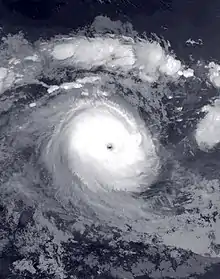Tropical cyclones in 2021
In 2021, tropical cyclones have formed in four major bodies of water, commonly known as tropical cyclone basins. Tropical cyclones will be named by various weather agencies when they attain maximum sustained winds of 35 knots (65 km/h; 40 mph). During this year, seventeen systems have formed, with eight being named. So far the most intense is Faraji, with a maximum sustained wind speed of 230 km/h (145 mph) and minimum pressure of 925 hPa (27.32 inHg), the deadliest tropical cyclone is Eloise with twenty one fatalities and the costliest was a depression from the West Pacific in which damages cost was US$10.8 million as of February 2021.
| Tropical cyclones in 2021 | |||||
|---|---|---|---|---|---|
| Year boundaries | |||||
| First system | Imogen | ||||
| Formed | January 1, 2021 | ||||
| Strongest system | |||||
| Name | Faraji | ||||
| Lowest pressure | 925 mbar/hPa; 27.32 inHg | ||||
| Longest lasting system | |||||
| Name | Eloise | ||||
| Duration | 11 days | ||||
| Year statistics | |||||
| Total systems | 17 (1 unofficial) | ||||
| Named systems | 8 | ||||
| Total fatalities | 23 total | ||||
| Total damage | $10.8 million (2021 USD) | ||||
| |||||
Tropical cyclones are primarily monitored by a group of ten warning centres, which have been designated as a Regional Specialized Meteorological Center (RSMC) or a Tropical Cyclone Warning Center (TCWC) by the World Meteorological Organization. These are the United States National Hurricane Center (NHC) and Central Pacific Hurricane Center, the Japan Meteorological Agency (JMA), the Indian Meteorological Department (IMD), Météo-France (MFR), Indonesia's Badan Meteorologi, Klimatologi, dan Geofisika, the Australian Bureau of Meteorology (BOM), Papua New Guinea's National Weather Service, the Fiji Meteorological Service (FMS) as well as New Zealand's MetService. Other notable warning centres include the Philippine Atmospheric, Geophysical and Astronomical Services Administration (PAGASA), the United States's Joint Typhoon Warning Center (JTWC), and the Brazilian Navy Hydrographic Center.
Global atmospheric and hydrological conditions
At the start of 2021, the COVID-19 pandemic continued to disrupt the response to tropical cyclones, while a La Nina episode persisted in the Pacific Ocean. Tropical Depression 05 and Severe Tropical Storm Danilo persisted into 2021, after developing within the South-West Indian Ocean during December 2020.
Summary

Western Pacific Ocean
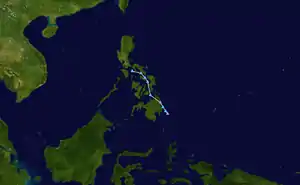
On January 19, a tropical depression formed which became the first Northern Hemisphere tropical cyclone of the year and of the 2021 Pacific typhoon season.[1]
South-West Indian Ocean
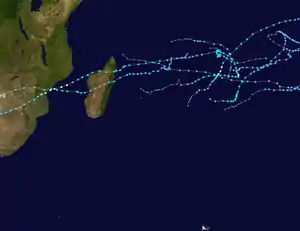
January - June
From the 2020 season, two systems crossed into the 2021 season after having formed during the previous year, Danilo peaked as a high end severe tropical storm and briefly passed near the Mascarene Islands and a tropical depression designated as 05 which entered the South-West Indian Ocean basin on January 28, caused a Fujiwhara effect with Danilo and dissipated on January 3. In the 2021 season, one disturbance formed in the South-West Indian Ocean, which intensified further to become Eloise. It rapidly intensified into a tropical cyclone on the Mozambique Channel and made a second landfall in Beira. Its remnants affected Zimbabwe, Eswatini and South Africa. Meanwhile, Joshua from the Australian region entered into the basin on the same day. On January 27, 10U from the Australian region entered the basin and designated as Tropical Depression 09 but dissipated soon thereafter rapidly. On February 4, a tropical depression formed and intensified into Cyclone Faraji which further intensified into the season's first intense and very intense tropical cyclone.
Australian Region
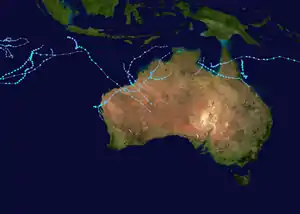
January - June
At the beginning of the 2021 season, a new low formed in the Australian region near the Northern Territory of Australia which further intensified into the first named cyclone of 2021 named Imogen, which made landfall in Far North Queensland. Another low formed northeast of Cocos Islands which lasted for five days and dissipated on January 10. Joshua formed on January 13 and crossed into the South-West Indian Ocean basin four days later. A new low formed on January 16 near Queensland which intensified into Tropical Cyclone Kimi on the very next day. Four additional lows formed after Kimi, one of which intensified into Tropical Cyclone Lucas and crossed into the South Pacific basin on February 3, while the other three had minor effects on land.
South Pacific Ocean
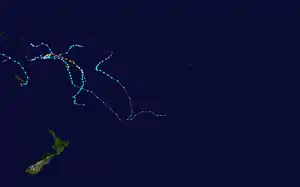
January - June
In January 2021, four disturbances formed in the South Pacific, all four of which intensified into tropical depressions, with Ana and Bina intensifying into tropical cyclones. On the first day of February, Lucas entered from the Australian region and affected New Caledonia and Vanuatu. The season's ninth tropical depression followed on February 7.
Systems
January
January was above average in tropical cyclone formation with fourteen tropical cyclones forming and seven being named. Before that, two systems crossed into the 2021 season after having formed during the previous year, Danilo peaked as a severe tropical storm and briefly passed near the Mascarene Islands and a tropical depression designated as 05 which entered the South-West Indian Ocean basin on December 28, caused a brief interaction with Danilo and dissipated on January 3. In the Australian region, Imogen formed on January 1 and affected Far North Queensland with minimal damage. Following Imogen, three named storms, Joshua and Kimi, developed, with Joshua later entering the South-West Indian Ocean on January 17 while Kimi threatened to affect Queensland as a Category 2 tropical cyclone but weakened suddenly due to unexpected wind shear and Lucas formed January 25 and entered the South Pacific basin on February 1. Additionally, four tropical lows formed in the basin, out of which one system entered the South-West Indian Ocean basin. In the South-West Indian Ocean, Eloise formed and first made landfall in Madagascar as a severe tropical storm. It rapidly intensified over the Mozambique Channel and became the strongest storm of the month shortly before making a damaging landfall in Mozambique and its remnants affecting Zimbabwe, Eswatini and South Africa. In the West Pacific, a depression formed which became the first Northern Hemisphere tropical cyclone of 2021 and marked the beginning of the 2021 Pacific typhoon season. In the South Pacific, Ana and Bina formed, including two depressions affecting Fiji and Vanuatu.
| Storm name | Dates active | Max wind km/h (mph) |
Pressure (hPa) |
Areas affected | Damage (USD) |
Deaths | Refs |
|---|---|---|---|---|---|---|---|
| Imogen | January 1 – 6 | 85 (50) | 989 | Northern Territory, Far North Queensland | Unknown | None | |
| 06U | January 5 – 10 | 65 (40) | 1002 | None | None | None | |
| Joshua | January 13 – 19 | 85 (50) | 991 | Cocos Islands | None | None | |
| Eloise | January 14 – 25 | 150 (90) | 967 | Madagascar, Mozambique, Malawi, Zimbabwe, South Africa, Eswatini | Unknown | 21 | |
| 08U | January 15 – 23 | 65 (40) | 998 | Northern Territory, Western Australia | None | None | |
| Kimi | January 16 – 19 | 100 (65) | 987 | Queensland | None | None | |
| 09 | January 19 – 28 | 75 (45) | 995 | Cocos Islands | None | None | |
| TD | January 19 – 20 | Not specified | 1008 | Philippines | $10.8 million | 1 | [2] |
| 04F | January 22 – 28 | Not specified | 999 | Vanuatu | None | None | |
| Lucas | January 25 – February 3 | 110 (70) | 975 | Northern Territory, Far North Queensland Vanuatu, New Caledonia | Unknown | None | |
| Ana | January 26 – February 1 | 120 (75) | 970 | Fiji | Unknown | 1 | |
| 06F | January 27 – 28 | Not specified | 998 | Fiji | None | None | |
| 12U | January 28 – February 5 | 55 (35) | 992 | Northern Territory, Western Australia | None | None | |
| Bina | January 29 – 31 | 65 (40) | 995 | Vanautu | None | None | |
February
February so far has produced three systems with one being named, of which one system was unofficial. In the South-West Indian Ocean, Faraji formed and rapidly intensified to a very intense tropical cyclone, although it stayed well away from any landmasses. It strengthened into the first category 5-equivalent in the basin since Fantala in 2016 and the first in February since 2005 as well as the first category 5 tropical cyclone of the year. In the Australian region, a tropical low formed near Northern Territory and quickly made landfall. In the South Pacific, a tropical disturbance formed north of Fiji and strengthened. In the South Atlantic one system was unofficially monitored by NOAA which was designated as 01Q.
| Storm name | Dates active | Max wind km/h (mph) |
Pressure (hPa) |
Areas affected | Damage (USD) |
Deaths | Refs |
|---|---|---|---|---|---|---|---|
| Faraji | February 4 – Present | 230 (145) | 925 | None | None | None | |
| 01Q | February 6 | 65 (40) | 990 | None | None | None | |
| TL | February 6 – 7 | Not specified | 996 | Northern Territory | None | None | |
| 09F | February 7 – Present | 45 (30) | 998 | None | None | None | |
Global effects
There are a total of 9 tropical cyclone basins, 7 are seasonal and two are non-seasonal, thus all 7 basins except the Mediterranean and South Atlantic are active. In this table, data from all these basins are added.[3]
| Season name | Areas affected | Systems formed | Named storms | Damage (USD) | Deaths | Ref |
|---|---|---|---|---|---|---|
| 2021 Atlantic hurricane season | None | 0 | 0 | None | None | |
| 2021 Pacific hurricane season | None | 0 | 0 | None | None | |
| 2021 Pacific typhoon season 3 | Philippines | 1 | 0 | $10.8 million | 1 | |
| 2021 North Indian Ocean cyclone season | None | 0 | 0 | None | None | |
| 2020–21 South-West Indian Ocean cyclone season 2 | Eswatini, Madagascar, Malawi, Mozambique, Zimbabwe, South Africa | 2 | 2 | Unknown | 21 | |
| 2020–21 Australian region cyclone season 2 | Cocos Islands, Far North Queensland, Northern Territory, Queensland, Western Australia | 9 | 4 | Unknown | None | |
| 2020–21 South Pacific cyclone season 2 | Fiji, New Caledonia, Vanuatu | 5 | 2 | Unknown | 1 | |
| Worldwide | (See above) | 17 | 8 | $10.8 million | 23 |
Notes
2 Only systems that formed either on or after January 1, 2021 are counted in the seasonal totals.
3 Only systems that formed either before or on December 31, 2021 are counted in the seasonal totals.
4 The wind speeds for this tropical cyclone/basin are based on the IMD Scale which uses 3-minute sustained winds.
5 The wind speeds for this tropical cyclone/basin are based on the Saffir Simpson Scale which uses 1-minute sustained winds.
6The wind speeds for this tropical cyclone are based on Météo-France which uses wind gusts.
References
- "WWJP27 RJTD 191800". Archived from the original on 2021-01-20. Retrieved 2021-01-25.
- ""SitRep no.09 re Prep. Measures and Effects for TEFS in Reg V, VI, VIII and X"" (PDF). January 20, 2021.
- B. S., Atmospheric Sciences and Meteorology. "Prefer to Live or Vacation Near These Oceans? So Do Hurricanes". ThoughtCo. Retrieved 2020-12-19.
External links
| Tropical cyclone year articles (2020–present) |
|---|
| 2020, 2021, Post-2021 |
Regional Specialized Meteorological Centers
- US National Hurricane Center – North Atlantic, Eastern Pacific
- Central Pacific Hurricane Center – Central Pacific
- Japan Meteorological Agency – West Pacific
- India Meteorological Department – Bay of Bengal and the Arabian Sea
- Météo-France – La Reunion – South Indian Ocean from 30°E to 90°E
- Fiji Meteorological Service – South Pacific, west of 160°E, north of 25° S
Tropical Cyclone Warning Centers
- Meteorology, Climatology, and Geophysical Agency of Indonesia – South Indian Ocean from 90°E to 141°E, generally north of 10°S
- Australian Bureau of Meteorology (TCWC's Perth, Darwin & Brisbane) – South Indian Ocean & South Pacific Ocean from 90°E to 160°E, generally south of 10°S
- Papua New Guinea National Weather Service – South Pacific Ocean from 141°E to 160°E, generally north of 10°S
- Meteorological Service of New Zealand Limited – South Pacific west of 160°E, south of 25°S
- US Joint Typhoon Warning Centre – Monitors the East Pacific, Central Pacific, West Pacific, South Pacific, North Indian Ocean and South Indian Ocean

